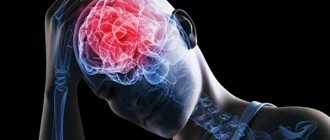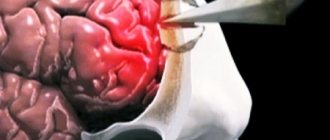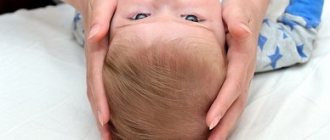Today we will talk about something that, unfortunately, often happens in children in the first year of life - traumatic brain injuries. For children, the most traumatic ages are considered to be 3 - 4 months, 1 - 1.5 years, 7 - 10 years. From 3 to 4 months, the baby masters turning over from his stomach to his back, his first independent change in body position in space. At the age of about 1 year, the baby learns to walk, but often loses its balance, hitting objects and falling. The age from 7 to 10 years marks the beginning of a child’s independent social life, when he goes to school, for a walk, etc., unaccompanied by adults.
As already mentioned, from 3 to 4 months the child masters turning over from back to stomach. Before starting to roll over, the baby trains, turns first on one side, then on the other, throws his leg, grunts, trying to turn over, and at some point turns over.
As a rule, such a metamorphosis is unexpected for adults caring for the baby, because they have managed to get used to the image of the child obediently lying on his back. This is where danger awaits us. As soon as the mother gets distracted for a second, takes a step to the side, the child falls. In 9 out of 10 cases, children fall from the changing pad, and since the heaviest part of the body is the head, the fall occurs head down.
According to statistics, in infancy, about 40% of children fall from a height, but, fortunately, nature took care of the babies and endowed them with a “margin of safety” in the form of an open fontanel, soft sutures between the bones of the skull, a large intracranial space, so only 1. 5% of falls from height have serious consequences. However, as practice shows, even if everything ended well, the horror of the experience and the feeling of guilt settle in the mother’s heart for a long time.
What to do if a child falls?
Try not to panic, take the child in your arms, calm him down, call an ambulance.
According to emergency care standards, every child with a head injury should be hospitalized. This usually happens like this: an ambulance delivers the baby and his mother to the emergency room of a specialized hospital, where the neurosurgeon on duty examines the child, conducts an ultrasound examination of the brain, and x-rays of the skull bones. If the baby’s condition does not cause concern and the examination reveals nothing wrong, the mother and child can be sent home under the supervision of a neurologist at their place of residence.
If, during examination, the baby cries continuously, or, conversely, is lethargic, or there is weakness in the arm or leg and the baby cannot move them, or there was repeated vomiting, or changes were detected during ultrasound examination and x-ray, then the child remains in the hospital and receives treatment according to the degree of traumatic brain injury.
Treatment uses medications that reduce swelling of the brain tissue, improve blood flow and metabolic processes in the nervous tissue.
An intracerebral hematoma can become a serious complication of traumatic brain injury, when blood from damaged vessels pours into the cranial cavity, which inevitably leads to compression of the brain. In such a situation, urgent surgery is required to remove the hematoma.
When the child’s condition becomes stable, he is discharged home under the supervision of a neurologist.
Head injury: emergency care
Head impacts and blows to the head occur repeatedly in every child's life.
A fundamental feature of children in the first year of life is the fact that the amount of fluid in the cranial cavity is much higher than that in older children and (or) adults. In addition, the baby’s brain is not tightly closed in the cranium, since there are fontanelles, as well as pliable and movable sutures between the bones of the skull. All this creates the possibility of shock absorption and to some extent reduces the risk of impacts to the head and head.
The vast majority of head injuries end safely and are not accompanied by any serious consequences. However, any blow to the head (to the head) potentially requires serious consideration , since very dangerous damage to the brain substance and bleeding in the cranial cavity are possible.
A very common specific condition that occurs after a head injury is called concussion .
Medical science still does not know exactly what happens to the brain during a concussion. It is assumed that during an injury, the brain substance is shaken and hits the skull from the inside. As a result, connections between brain cells and its parts are disrupted. All this is accompanied by very specific symptoms, primarily disorders of consciousness. The fundamental point is that the integrity of the brain tissue is not damaged during a concussion.
A head injury may be accompanied by damage to the brain substance with the development of edema and hemorrhage. In this case, they talk about a brain contusion .
Severe swelling of the brain tissue and intracranial hematomas lead to a very dangerous condition - compression of the brain .
Shake
,
bruise
and
compression
of the brain are united by such a concept as
traumatic brain injury .
Traumatic brain injury can be closed (without violating the integrity of the bones of the skull) and open (respectively, with violating the integrity of the bones).
Between the inner surface of the skull bones and the brain matter itself is the dura mater. An open traumatic brain injury with damage to the dura mater is called penetrating .
If, as a result of the impact, only soft tissues are damaged (skin, subcutaneous tissue above
bones of the skull) and there is no disorder of consciousness, then this condition is called
head contusion .
All of the technical terms listed are medical diagnoses. The diagnosis is made by a doctor.
However, there are very clear symptoms that indicate that a head injury is potentially dangerous and requires mandatory medical attention.
The task of parents is to know these symptoms and provide emergency assistance.
Attention!
Seek medical help if following a head injury:
- disturbance of consciousness of any severity and any duration;
- speech disorders;
- inappropriate behavior;
- unusual drowsiness;
- intense headache that persists for more than one hour after the injury;
- convulsions;
- more than one episode of vomiting;
- dizziness and/or imbalance that persists for more than one hour after injury;
- inability to move an arm or leg, weakness in an arm or leg;
- pupils of different sizes;
- the appearance of dark (dark blue) spots under the eyes or behind the ears;
- bleeding from the nose or ears;
- discharge of colorless or bloody fluid from the nose or ears; After the injury, the child cried, and while crying, like all children, he sniffled. I stopped crying, but I still had a runny nose, which was not there before the injury. To the doctor!
- After an injury, hearing becomes worse or something is wrong, fog or double vision, unusual taste in the mouth, something doesn’t smell right, decreased skin sensitivity, goosebumps... See a doctor!
Regardless of the symptoms, seeking medical help is necessary if a head injury was sustained while intoxicated or under the influence of drugs.
ATTENTION!
Dangerous symptoms may not appear immediately, so parents should closely monitor their child for at least 24 hours after a head injury, even if the injury appears to be minor.
If after the injury the child calms down and falls asleep, he should be woken up every 2-3 hours and asked simple questions (what is your name?, etc.).
Once again, any head injury is potentially dangerous. The slightest doubt - see a doctor!
Emergency care for head injury
There are no dangerous symptoms:
- calm the child down;
- try your best to limit physical activity (lay down and read, avoid active games, etc.);
- Apply cold to the injured area.
If dangerous symptoms are detected:
- Assess the state of breathing and circulation, and in critical condition, begin cardiopulmonary resuscitation;
- if breathing and blood circulation are preserved, but there is no consciousness, try to keep the child in a supine position, on a hard, flat surface, support the head with your hands; Monitor breathing carefully: if breathing is difficult in this position due to vomiting or excess saliva, place the child in a stable position on his side . When turning, hold your head, trying to avoid its rotation, excessive throwing back and lateral tilt;
- while waiting for help (optimally in the supine position, even before turning to a stable lateral position), it is advisable to immobilize the cervical spine ;
- if the child is conscious, wait for help in the supine position without a pillow;
- do not give food or drink;
- Do not move the child unless absolutely necessary.
When stopping bleeding:
- follow the general rules for stopping bleeding and treating a wound ;
- at the slightest suspicion of damage to the skull bones, categorically avoid direct pressure on the wound - cover the wound with a dressing material, do not remove foreign bodies from the wound.
(This publication is a fragment of the book by E. O. Komarovsky “Handbook of Sensible Parents. Part 2. Emergency Care” adapted to the format of the article.)
What can be the consequences of injury?
In most cases, as already mentioned, infant falls end happily and do not affect the child’s development in any way. In 15% of cases, cerebrasthenic syndrome develops, when the child is often capricious, gets tired quickly, and does not gain weight and height well. This condition, without treatment, can last for several months and often causes developmental delays.
Such severe diseases as post-traumatic epilepsy, mental retardation, and cerebral palsy are formed as a result of brain injury in approximately 1.5% of cases. All patients with such a diagnosis are considered disabled; they require comprehensive rehabilitation treatment and supervision by specialists for many years, but even using the most modern treatment methods, it is not possible to completely get rid of the defect.
To avoid unpleasant consequences, do not lose your vigilance, especially if your child is approaching 3 months.
Help with bruises in children
Even a minor bruise causes discomfort to the baby, so parents should not ignore such injuries. There are a number of activities that are carried out as part of the provision of first aid for bruises in children :
- It is necessary to provide rest to the injured area. It is advisable to put the child to bed for a while. Moreover, if a limb is injured, then it needs to be given a slightly elevated position, which will ensure the outflow of blood and lymph from the site of the injury - this will both reduce the intensity of pain and prevent the formation of swelling.
- Cold must be applied to the injury site. This could be ice from the refrigerator, a heating pad with ice water, a wet towel/handkerchief, or a metal object (spoon). Cold can quickly relieve pain, and if applied immediately after an injury, it can also prevent the appearance of swelling and hematoma.
- If the bruise is accompanied by a violation of the integrity of the skin (there are abrasions, scratches and wounds), then this area should be washed with water, dried and treated with any antiseptic - for example, bruise ointment for children with calendula in the composition.
- The site of injury should be treated with ointment for bruises and hematomas for children and this procedure should be continued until complete recovery.
Please note: if a child cannot move a limb or fingers after a bruise, swelling in the area of injury rapidly increases, or there is intense bleeding, then this is a reason to call an ambulance. But before the doctors arrive, parents can apply cold to the site of the injury and provide peace to the baby - in any case, such measures will be useful.
Symptoms of injury to the head and its occipital part
If someone around you hits the back of the head or any part of the head, after which he experiences dizziness, nausea, poor health, and drowsiness - these are the first signs of a concussion. The injured person needs first aid, and then emergency care to prevent the condition from worsening.
Symptoms for head injuries are quite varied, but there are some that can be used to fairly accurately determine which part of the head was damaged. This is especially true for bruises on the back of the head. Damage to this area often leads to visual impairment, since the occipital region of the head is responsible for control in space.
Headbutt
When you hit your head, you feel a strong pain that disappears after a while. When a person falls and hits any part of the head, within a few minutes a small “bump” forms at the site of the injury as a result of tissue swelling. This happens with a slight blow to the head. For more serious injuries, the following symptoms may occur:
- drowsiness;
- dizziness;
- mild nausea;
- double vision;
- partial numbness of the limbs.
Hit with the back of the head
With a strong blow to the back of the head, the following symptoms are observed:
- vomit;
- loss of consciousness lasting from several minutes to several hours;
- speech problems;
- temporary blurred vision; ;
- numbness of all limbs for some time;
- numbness of facial muscles.
What can be done
If there is no obvious damage to the bones of the skull, a cloth moistened with cold water or ice in a rag should be applied to the site of impact. This will reduce pain and stop tissue swelling and bleeding. Bleeding can be stopped in this way - by applying a thick piece of dry cloth (tampon) to the wound. If it becomes saturated with blood, place a second one on top of the first tampon. Attention! If bleeding continues after 15 minutes, call a doctor immediately. After any head injury, the child needs rest , but do not let him fall asleep for an hour , otherwise you will not understand how serious his condition is. Wake up your baby at night too. If he does not answer simple questions, or has poor coordination of movements, or vomiting repeatedly, call a doctor immediately. Pay attention to the pupils: their unequal size indicates severe brain damage. If you suspect a serious injury, and the baby has fallen asleep, do not wait until he wakes up: call a doctor. If a child has lost consciousness after hitting his head and you have already called an ambulance, lay the baby on his side so that vomit does not enter the respiratory tract. If you suspect that, in addition to the brain, the spine has been damaged (from a fall from a height onto the head or back), the child must be turned extremely carefully and so that the body and head are on the same axis: this will help avoid additional injury. But still, the most important thing that is required of you if a child is injured is to remain calm. Too much depends on the adequacy of your reactions - the health of a little person depends. Material provided by the magazine “Family Doctor”
Concussion in a child: the devil is not as terrible as...
One of the most terrible and dangerous head injuries in a child, according to most parents, is a concussion.
But in reality, as it turns out, everything is exactly the opposite... Let us explain in a nutshell what generally happens when a child has a concussion. The head (including a child’s head), to put it very simply, consists of bone (a hard and relatively strong skull), which protects the soft, vulnerable and “delicate” brain enclosed inside this very bone. With a strong external blow that falls on the skull, the brain from the inside, in turn, also hits the wall of the skull. In this case, the brain cells at the site of this impact are not damaged, but for some time they lose their relationship with each other. This leads to loss of consciousness, most often extremely short-term.
The most obvious and obligatory symptom of a concussion in a child is loss of consciousness. If the baby did not “pass out”, then there is no talk of any concussion.
At the same time, parents should know that from a medical point of view, a concussion is one of the mildest and most harmless head injuries. In the vast majority of cases, after a concussion and loss of consciousness, the child comes to his senses and adapts very quickly.
The maximum ailments that can occur in a child after a concussion are a short headache, loss of appetite and drowsiness. However, after 1-2 days, these symptoms disappear without a trace.
The situation is completely different if the child suffers a brain contusion due to the impact.









